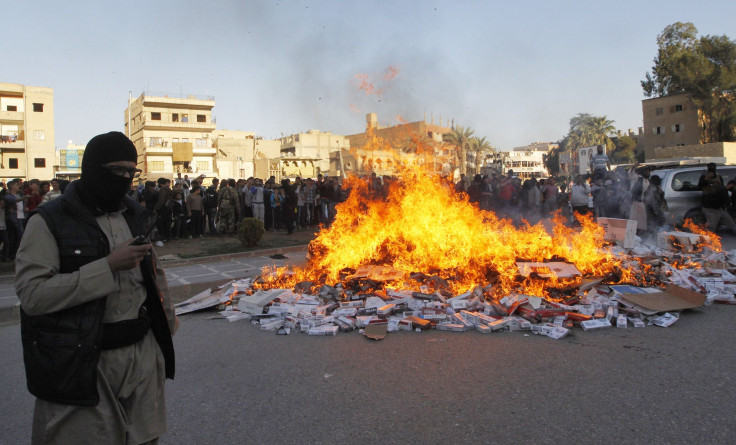How ISIS Shook Off al Qaeda And Became Even More Powerful In Iraq

Sometimes, even terrorist organizations need a divorce. On Feb. 3, 2014, al Qaeda formally severed its relationship with the Islamic State of Iraq and Syria (ISIS), a fellow terrorist organization. Problems between the two groups were numerous: al Qaeda felt that ISIS's targeting of civilians alienated the local population, and that the group -- Sunni hardliners -- did not share al Qaeda’s mission to unite all Muslims.
In the months since, ISIS has emerged from al Qaeda’s shadow. In the past two weeks, ISIS has captured Mosul, Iraq’s second-largest city, and Tikrit, the birthplace of former dictator Saddam Hussein. Videos that appear to show ISIS fighters executing Iraqi security forces -- most of whom fled rather than fight -- appeared on the Internet. The organization continues to maintain a major presence in neighboring Syria. Once just a branch of a declining al Qaeda, ISIS is now arguably stronger, more powerful -- and more feared -- than its fellow terror organization.
The splintering of al Qaeda and ISIS -- and the deadly consequences for Iraq -- demonstrate how, for the United States and its allies, the quest to eliminate Islamic terrorism has remained so elusive.
Radical Islamism, which has existed in Iraq for decades, flourished in the aftermath of the U.S. invasion in 2003, which removed the Sunni dictator Saddam Hussein from power. In the security vacuum that emerged during the American occupation, a Jordanian militant named Abu Musab al-Zarqawi conducted a series of violent attacks across the country, and in 2004 swore allegiance to al Qaeda and its founder, Osama bin Laden. Zarqawi’s group became known as al Qaeda in Iraq (AQI).
Before long, the relationship between the two groups began to fray. Zarqawi’s sectarianism -- he frequently targeted Iraqi Shias -- ran afoul of al Qaeda’s mission to unite all Muslims in a single caliphate. Zarqawi’s indifference to civilian casualties also posed a problem. In an extraordinary letter written in 2005 and later surfaced in the media, Ayman al-Zawahiri (a Bin Laden deputy) warned Zarqawi to focus on the “media battle” by winning the “hearts and minds” of the local population.
Zawahiri’s words proved to be prophetic. Iraq’s Sunni population soon began to cooperate with the Shia government and American forces, providing valuable intelligence that led to successful, coordinated attacks against the terrorist organization. Zarqawi himself was taken out by a U.S. airstrike in 2006, and AQI’s influence sharply faded.
But in the ensuing five years, the Shia Prime Minister Nouri al-Maliki reneged on a promise to integrate Sunnis into the Iraqi government. This development -- combined with the complete withdrawal of American troops in 2011 -- created a security vacuum in Sunni territories and made a population, shut out of legitimate government, amenable to sectarian politics. And when the Syrian uprising erupted in a full-scale civil war, with much of that country out of government control, the successor to AQI -- ISIS -- came in to fill the breach.
During its peak in the aftermath of the Sept. 11, 2001, attacks, al Qaeda was often described as a sort of “venture capital” organization, a decentralized force that financed and organized operations planned by others. ISIS, on the other hand, more closely resembles a conventional force.
“They’re ferociously well-organized … this isn’t a loosey-goosey network of guys who get together on the fly to do operations,” said Austin Long, an expert in Middle East politics at Columbia University.
“This isn’t just a terrorist organization, or an insurgent organization. It’s more of a military organization.”
ISIS’s hierarchy has allowed them to capture Syrian and Iraqi territory with systematic efficiency, withstanding large, well-equipped military forces of two separate sovereign states. That, combined with their brutality -- ISIS fighters released propaganda videos Sunday announcing the execution of over 1,700 Iraqi security forces -- make them a more formidable force in the region than al Qaeda has been.
Can ISIS be stopped? In 2006, when Abu Musab al-Zarqawi reached the height of his influence and power in Iraq, the Sunni population declared its allegiance to the Iraqi government and turned against al Qaeda. That -- combined with American military power -- enabled Iraq to push al Qaeda back.
The same scenario is unlikely to play out this time. The United States and its allies have shown little inclination to commit ground forces to the country, and, Long said, the utility of air strikes are likely to be minimal without local intelligence. Also, given that Maliki broke an earlier promise to the Sunnis, they’ll be less willing to compromise in the future. ISIS appears to have staying power.
After 13 years of being in the international spotlight, al Qaeda is a shell of its former self -- a fact frequently touted by President Obama. But a larger, more violent, better-organized organization has emerged, and already controls an area the size of Belgium.
© Copyright IBTimes 2024. All rights reserved.






















